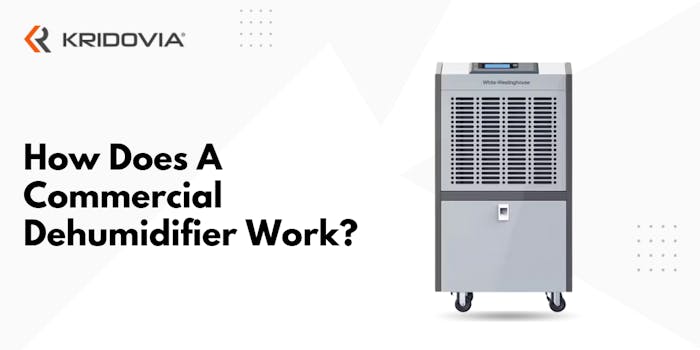Recommended: The Ultimate Dehumidifier Maintenance Checklist
What Are The Components of A Commercial Dehumidifier?
A commercial dehumidifier is made up of several important parts that work together to remove excess moisture from the air. The main parts of a commercial dehumidifier are as follows:
Compressor
The dehumidifier's compressor functions as its brain. It compresses the refrigerant, increasing its pressure and temperature.
Evaporator Coil
The air cooling process is carried out by the evaporator coil. Moisture condenses as a result of heat absorption by the compressed refrigerant as it passes through the evaporator coil.
Condenser Coil
The condenser coil works in conjunction with the evaporator coil. After the refrigerant absorbs heat in the evaporator coil, it moves to the condenser coil. Here, it releases the heat it absorbed, transferring it outside the dehumidifier.
Refrigerant
The refrigerant is a unique chemical substance. It moves through the system, changing between the liquid and gaseous phases as it absorbs and releases heat.
Fan
The dehumidifier's fan helps in air circulation. It facilitates the draws moist air from the surroundings and direct it across the evaporator coil. The fan also helps distribute dehumidified air back into the space.
Drainage System
Commercial dehumidifiers have a drainage system built in to collect and remove the condensed moisture. It may include a condensate pump or a drain pan joined to a drain pipe.
Control Panel
Users can set and modify many parameters on the control panel, including humidity levels, fan speeds, and operation modes. It offers a simple user interface for controlling the dehumidifier's performance.
Air Filters
Air filters are crucial parts that remove dust, dirt, and airborne particles. They improve indoor air quality and support dehumidifier efficiency.
Understanding How Does A Commercial Dehumidifier Work
The dehumidification process involves several steps for removing excess moisture from the air. An overview of the dehumidification procedure is given below:
Air Intake
The dehumidifier's intake vent draws humid air from the surrounding area.
Filtration
The air is filtered before it is introduced to the dehumidifier. These filters capture dust, allergies, and other airborne particles, enhancing air quality.
Cooling
Incoming humid air enters the dehumidifier and makes contact with the cooling coils. Refrigerant is used to chill these coils, which causes the moisture in the air to condense into water droplets.
Condensate Collection
Droplets of condensed water drip from the cooling coils and accumulate in a drain pan or are removed by a condensate pump. This collected water is then directed to a drainage system or a collection tank for disposal.
Reheating
After the moisture is removed, the air is heated using a heating element or a heat exchanger. This process ensures that the dehumidified air is at a comfortable temperature before it is released back into the air.
Air Circulation
The dehumidified air is circulated back into the area by a fan inside it. This facilitates the conditioned air's equal distribution throughout the space.
Humidity Control
The dehumidifier measures the humidity levels in the surrounding area using a hygrometer. It modify operation to keep the intended humidity range constant based on the selected humidity level.
Conclusion
Commercial dehumidifiers are essential for maintaining a comfortable and healthy atmosphere. Hence, investing in a branded commercial dehumidifier ensure best performance, and energy savings. All these factors contribute to a pleasant and thriving working environment for your business.








